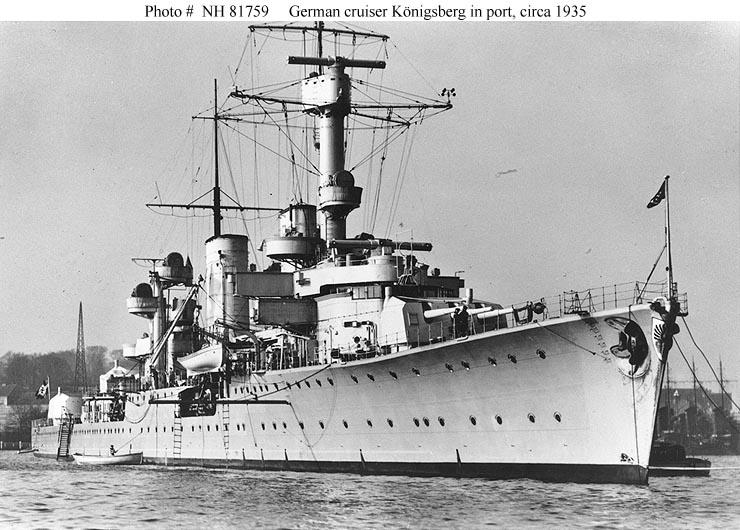German Light Cruiser Königsberg
Full Title: German Light Cruiser Königsberg (1929-1940) moored in a German harbor, circa 1935. (U.S. Naval Historical Center Photograph NH#81759)
The Königsberg was a German Weimer-era Reichsmarine light cruiser, laid down in 1926 and launched in 1927 at Wilhelmshaven, Germany. The Königsberg was the first ship in her class; a class which also included the Köln and Karlsruhe. The ship's primary armament was in and of itself sufficient - consisting of three triple turreted 5.9-inch (15cm) guns. That said, the ship was not well suited to service on the open ocean, and during the 1930s she went through numerous upgrades in an attempt to somewhat alleviate her otherwise inadequate design. Commissioned in April 1929, the Königsberg spent much of her service touring foreign ports and involved in training exercises; though she deployed along the Spanish Coast for a brief stint during the Spanish Civil War.
During the first six months of the Second World War the Königsberg, when deployed, did so in mere training operations in the Baltic Sea and mine laying operations in the North Sea. However, when Hitler decided to invade Norway in April 1940 the Kriegsmarine was hardly prepared to conduct large-scale amphibious landings, and thus gathered the bulk of its available surface fleet to ferry German troops to Norway. This lead to the Königsberg's first serious combat deployment - it would also be her last.
The Königsberg's target was the Norwegian port city of Bergen. Having managed to make it to Bergen on April 9th without running into Allied warships, the nearly 600 foot long Königsberg was able to unload her complement of troops and support the German landings by engaging Norwegian defensive positions. As was the case elsewhere on Norway's coast, defending Norwegian shore batteries proved to be both accurate and deadly. Within a short period the Königsberg had absorbed significant damage that severely hampered her mobility. Though German troops quickly took Bergen and the Königsberg successfully evaded one subsequent British air raid, what remaining luck she may have had soon ran out. On April 10th a follow up air raid led by British dive-bombers found the battered Königsberg and repeatedly hammered the German light cruiser with multiple bomb hits, forcing the crew to abandon ship before she sank.
The ability of the Germans to seize Norway by landing troops almost at will up and down the Norwegian coast was a severe blow to Allied naval prestige. On the other hand, the Königsberg's fate was far from unique, and overall the Kriegsmarine suffered crippling losses to its surface fleet during the Scandinavian campaign. As a result, one long-term strategic result to emerge from Germany's Scandinavian adventure was that Britain had taken perhaps the most crucial step in guaranteeing she would not suffer the same fate as Norway.
Picture Courtesy of the Department of the Navy - Naval Historical Center


